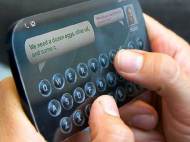Tactus technology – haptic feedback on dynamic user interface
 Although touchscreens managed to change the way we interact with information, particularly with information on our portable devices, they provide insufficient tactile feedback. Unlike other tactile feedback technologies we previously covered, a Californian company Tactus came up with haptic feedback technology which creates physical buttons that can act as a mechanical keyboard. Tactus offers solution to both orientation and feedback problems that are common on current touch screens.
Although touchscreens managed to change the way we interact with information, particularly with information on our portable devices, they provide insufficient tactile feedback. Unlike other tactile feedback technologies we previously covered, a Californian company Tactus came up with haptic feedback technology which creates physical buttons that can act as a mechanical keyboard. Tactus offers solution to both orientation and feedback problems that are common on current touch screens.
Current haptic technologies which rely on vibrations fall short in assisting users to properly locate their fingers on the screen or keyboard, since they still remain being flat up until you make a contact with the surface. Tactus technology is easy to integrate – the tactile panel replaces the glass or plastic layer that sits on top of the touch sensor and display on a touchscreen. It is essentially a thin, flat, smooth and transparent cover layer varying in thickness from about 0.75mm to 1mm (0.03 to 0.04 inches).
The cover is made of a thin multi-layered stack, where the top-most layer consists of an optically clear polymer. A number of micro-holes connect the top layers of the panel to a series of micro-channels that run through the underlying substrate. The micro channels are filled with a fluid whose optical index of refraction matches that of the surrounding material, making it fully and evenly transparent when light from the display passes through.
So, how does it all work you ask? Increasing the fluid pressure causes the fluid to push up through the holes and against the top polymer layer, making it expand in pre-defined locations. This enables an array of physical and completely transparent buttons to rise out of the surface. A small internal controller that interfaces with the processor of the touchscreen device controls the rise and fall of the buttons. The controller allows a proximity sensor or a software application to control the state of the buttons. For example, the buttons could be triggered to rise whenever the software calls for the virtual QWERTY keyboard.
It takes less than one second for the buttons to rise or recede. Once formed, the buttons are stable and users can rest their fingers on them or type on them just like a regular keyboard. When the buttons aren’t needed the controller triggers a reduction of the fluid pressure. The buttons recede back into the Tactile Layer panel and the surface becomes smooth and flat again. The panel size as well as the size, shape and firmness of the buttons are fully customizable. Buttons can be of any shape – circles, rectangles, ovals, squares, long thin lines, or even ring- or donut-shaped. Their height (from high to low) and feel (from soft to rigid) can be precisely controlled.
It is possible to create almost any type of button configuration or layout on a panel, and that configuration is set in the manufacturing process. Multiple button sets can also be pre-configured on a single panel, enabling different groups of buttons to be raised at different times, depending on the interface needs of the user.
According to its developers, power requirements of the Tactile Controller used to actuate the panel are minimal. The system only consumes a small amount of power to raise or lower the buttons. Once the buttons are raised, they remain enabled for as long as they are needed – be it a few seconds or several hours – without any additional power consumption. This is possible because the pressure used to raise the buttons remains present, causing the buttons to automatically pop back up each time they are pushed. In contrast, vibration-based haptic feedback solutions continuously consume battery power each time a vibration is made.
Coatings similar to those used on touchscreens can also be used on the tactile surface to make it anti-fingerprint and scratch proof. Even if the touchscreen cracks, the tactile surface will function normally if it isn’t damaged since it is independent of both the touch sensor and the LCD screen.
Tactus technology could find various application, given how fast touchscreens are being integrated into handheld devices such as digital cameras, gaming systems and smart phones to larger systems such as cars, medical devices, ATM’s and home controls.









Leave your response!